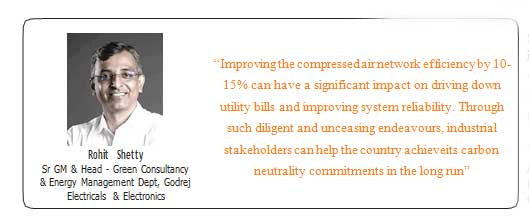
Tips to improve efficiency of compressed air systems in textile plants
Compressed air is one of the most expensive utilities in the textile industry. This case study shows how Godrej Compressed Air Solutions helps textile plants achieve energy savings through its compressed air network.
Godrej Compressed Air Solutions improved the efficiency of compressed airsystems in one of largest textile manufacturing company based in Gujarat, Western India – leading to energy savings of more than 991 kWh/day @ 3%
Foreword
Compressed air which is industry’s 4th utility is the most expensive utility, consuming approximately 15% to 20% of the total energy consumption of the entire factory in Textile industry sector.
This case study offers insights on how our compressed air solutions have helped one of the textile plants achieve energy savings through their compressed air network.
Overview
One of the largest Textile manufacturers based out of Ahmedabad.
This manufacturing facility in Ahmedabad has a manufacturing capacity of 110 MMTPA. Complete manufacturing process takes place through various shops like power plant, spinning mills and 138 looms. Each shop is highly dependent on compressed air for its processes which is fulfilled by a centralised compressed air network.
A major problem faced by the Textile manufacturer was very high energy consumption of air compressorsi.e.32,500 kWh/day, high artificial demand, pressure fluctuations & inconsistent pneumatic operation and product quality due to that.
So, the client decided to reduce their Air Compressors’ energy consumption by reducing their artificial air demand, optimize the flow and stabilize compressed air pressure with the help of Godrej Compressed Air Solutions (CAS) team.
Step 1- Feasibility study visit
Godrej CAS team conducted a feasibility study using data logging instruments in the existing compressed air network to understand the operation patterns of Compressors, variations in plant air demand and to work out a suitable solution along-with an estimation of envisaged energy savings.


The Textile manufacturer has been using the following air compressors to fulfill their compressed air requirements in various shops viz. Spinning mills, looms and Power plant.
Godrej CAS team installed instruments to simultaneously carry out real time data logging as a part of the feasibility study in the Textile products manufacturer’s compressed air system and analysed the gathered data to estimate the real air demand and artificial demand, the potential of Energy Saving in
Air Compressors.
Data logging instruments were installed at multiple locations viz:
A. Generation – Before dryer
B. Air treatment System After dryer
C. Application – In each shop viz. Spinning Mills,

Pressure drop was checked in compressor house as well as in application points
Step 2- Observations & findings
During the feasibility study, pressure fluctuation in Application was found to be86 psig (5.9 barg) to 92 psig (6.3 barg) which resulted in high artificial demand leading to increased energy consumption of air compressors.Compressor’s energy consumption was around 32,500 kWh/day
The status before: Pressure Variation in Compressed Air System from 86 psig to 92 psig
Step 3- Problems identified& solutions offered
After analyzing the measured data, Godrej CAS team worked out a suitable solution and submitted an energy saving proposal.
It was recommended to install Control AiR IFC- Demand Side Management Systems for every shop to reduce the Artificial Demand by optimizing flow & pressure supplied to each shop leading to huge energy savings and constant compressed air pressure in each shop could be achieved.
With installation of Demand Side Management
Control Systems it was envisaged to provide
Energy saving in Compressed Air System = 650 kWh/day @ 2% andConstant pressure to the plant = within +/- 1 psig (0.07 barg).
Step 4- Implementation & results


As per the recommendations, the manufacturer installed ControlAiR IFC systems for individual applications as below, By implementing the recommendations of the Godrej Compressed Air Systems, the Textile manufacturer was able to realise huge benefits such as constant air pressure in plant, reduced artificial demand and ultimately energy saving in Air Compressors.
Benefits
Actual Energy Saving achieved = 3% @991 kWh/dayConstant Air Pressure with ControlAiR™ IFCs = ±0.1 psigReduction in CO2 Emissions = 285T/yearSimple Payback Period = Less than 1.5 year
With Godrej ControlAiR IFCs installed in each shop
exact demand in terms of flow & pressure is matched and very stable pressure within +/- 0.1 psig is provided
Other benefits
With installation of Godrej ControlAiR™ IFC Systems the pressure in application was observed to be constantwithin +/- 0.1 psig. Constant pressure in the plant helps in
Improves pneumatic equipment performanceImproves product qualityReduction in Compressed Air Leakages
Real time pressure trends with Godrej ControlAiR IFCs in each application


Air compressors performance with & without IFC
The Textile manufacturer had Centrifugal type compressors to fulfill the compressed air demand. Normally, it is said that energy saving on centrifugal compressors cannot be achieved. But Godrej CAS team with its extensive experience recommended a solution which directly impacted on working pattern of compressors leading to reduced artificial demand and good energy saving.

About the author:
Prasad Shrirame, Product Manager- Godrej Compressed Air Solutions, Godrej & Boyce




